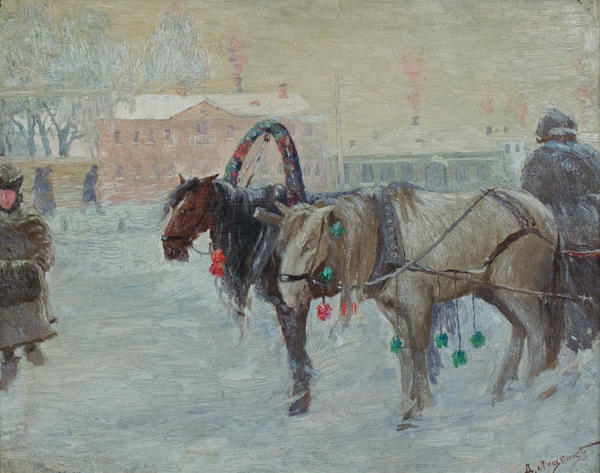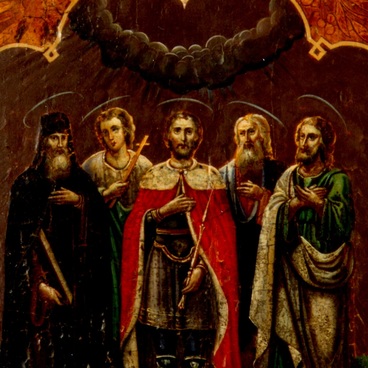On January 17, 1926, an art exhibition opened in the regional capital of Stavropol displaying 170 works of 13 artists. The event was covered in the local and regional newspapers. Journalists were making special note of the paintings by landscape artist Dmitry Lischenko. The exhibition showed over 60 of his works.
The artist was born in 1885 in Odessa, graduated from the Kiev Art School. In 1910s, he taught drawing and painting in the Stavropol Teachers’ Training Seminary, also taught at the Practical Public Education Institute. Once the Institute was closed in the early 1920s, Dmitry Lischenko moved to Leningrad to work at the Leningrad Geological Museum.
In 1926, a package came by mail addressed to Georgy Preve, Director of the Stavropol Museum of Regional Ethnography from Dmitry Lischenko. The package contained his pictures of pre-revolutionary Stavropol, including the picture of a Stavropol coachman conveying the atmosphere of a foggy winter morning with its frozen stillness. In the foreground, the artist placed two horses covered by white frost and the back of a stooping coachman wrapped in winter garb. Some occasional passersby and dwelling houses barely transpire through the frost mist. Chimneys are smoking. For all its illusory simplicity, everything in that small corner of Stavropol noticed seemingly by chance testifies to the artist’s great expertise in observing the natural surroundings.
Focusing his attention on the natural environment Lishenko managed to convey the transient nature of the scene. That is why the picture with its asymmetrical composition looks like a fragment. The transparency of color, the vibration of pure and sonorous paints in the air pictured – all that evokes anticipation of an upcoming frosty morning in the spectator. In his landscapes Lischenko worked a lot with snow trying to show its varying patterns. In the Stavropol Coachman, the snow surface is textured, dry, slightly frozen over the cold night.
In June 1942, Dmitry Lischenko died of emaciation during the siege of Leningrad and was buried in a mass grave in the Smolensky cemetery.
The Stavropol museum collection presently has eight paintings by Dmitry Lischenko: seven ones received from the Municipal Museum of Local Ethnography in 1962, and one more painted by Lischenko in his Stavropol period donated by an art collector in 1999.
The artist was born in 1885 in Odessa, graduated from the Kiev Art School. In 1910s, he taught drawing and painting in the Stavropol Teachers’ Training Seminary, also taught at the Practical Public Education Institute. Once the Institute was closed in the early 1920s, Dmitry Lischenko moved to Leningrad to work at the Leningrad Geological Museum.
In 1926, a package came by mail addressed to Georgy Preve, Director of the Stavropol Museum of Regional Ethnography from Dmitry Lischenko. The package contained his pictures of pre-revolutionary Stavropol, including the picture of a Stavropol coachman conveying the atmosphere of a foggy winter morning with its frozen stillness. In the foreground, the artist placed two horses covered by white frost and the back of a stooping coachman wrapped in winter garb. Some occasional passersby and dwelling houses barely transpire through the frost mist. Chimneys are smoking. For all its illusory simplicity, everything in that small corner of Stavropol noticed seemingly by chance testifies to the artist’s great expertise in observing the natural surroundings.
Focusing his attention on the natural environment Lishenko managed to convey the transient nature of the scene. That is why the picture with its asymmetrical composition looks like a fragment. The transparency of color, the vibration of pure and sonorous paints in the air pictured – all that evokes anticipation of an upcoming frosty morning in the spectator. In his landscapes Lischenko worked a lot with snow trying to show its varying patterns. In the Stavropol Coachman, the snow surface is textured, dry, slightly frozen over the cold night.
In June 1942, Dmitry Lischenko died of emaciation during the siege of Leningrad and was buried in a mass grave in the Smolensky cemetery.
The Stavropol museum collection presently has eight paintings by Dmitry Lischenko: seven ones received from the Municipal Museum of Local Ethnography in 1962, and one more painted by Lischenko in his Stavropol period donated by an art collector in 1999.



